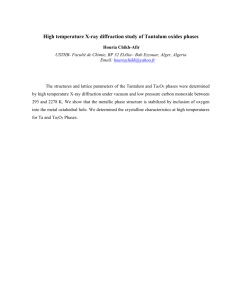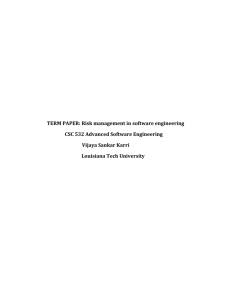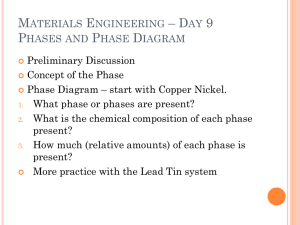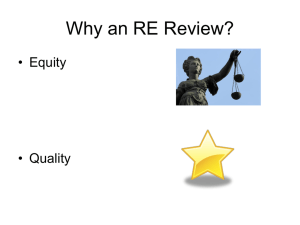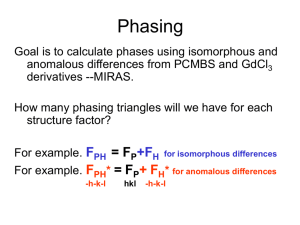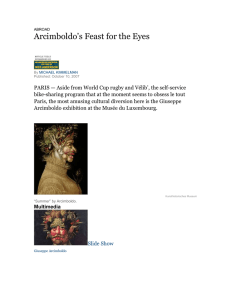George M. Sheldrick - In-house experimental phasing
advertisement
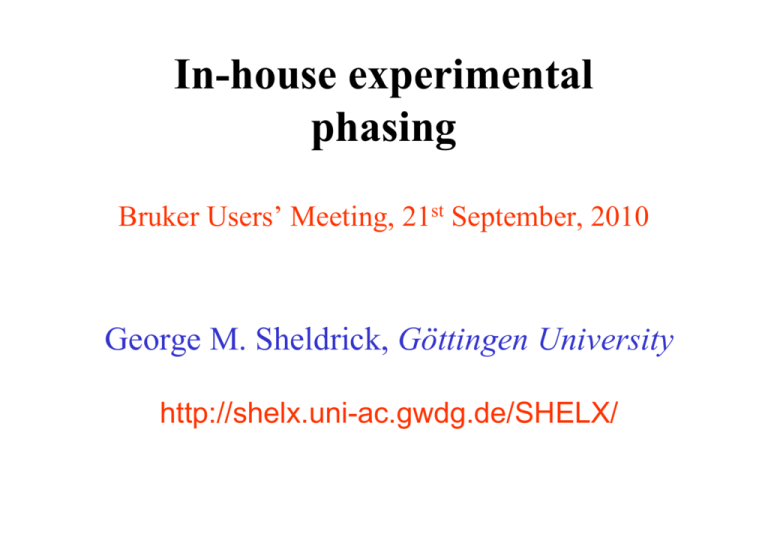
In-house experimental
phasing
Bruker Users’ Meeting, 21st September, 2010
George M. Sheldrick, Göttingen University
http://shelx.uni-ac.gwdg.de/SHELX/
Experimental phasing of macromolecules
Except in relatively rare cases where atomic resolution data permit the
phase problem to be solved by ab initio direct methods, experimental
phasing usually implies the presence of heavy atoms to provide
reference phases A. We then calculate the starting phases T of the full
native structure by:
T = A +
Where A is the calculated phase of the heavy atom substructure. As we
will see, can be estimated from the experimental data. The phase
determination requires the following stages:
1. Locate the heavy atoms using estimates FA of the structure factors of
the heavy atom substructure.
2. Possibly refine the heavy atom parameters, then use them to
calculate the reference phases A.
3. The native structure factors FT and starting phases T = A + give an
electron density map that is then improved by density modification.
SAD phasing
For experimental phasing we require FA (the heavy atom structure
factor), FT (the native structure factor, including heavy atoms if present
in the native data) and for each reflection. In theory this is enough to
solve the phase problem!
For a MAD or SIRAS experiment we have at least three observations
per reflection and can deduce FA, FT and from the data. For SAD
phasing we unfortunately only have two observations per reflection.
However we can assume |FT| = ½(|F+| +|F–|) and derive:
|F+| – |F–| = c|FA|sin
where c = 2f ”/f0; c is eliminated when we normalize to get EA.
Amazingly, this is sufficient to find the heavy atoms and to use them to
estimate the native phases T for some reflections. The key is to work
with the larger anomalous differences that will tend to be those with
close to 90° or 270°, so for these reflections we can estimate |FT|, |FA|
and !
Disulfide bond resolution
When the anomalous signal does not extend to sufficient resolution
to resolve disulfides, it has been standard practice to search for
super-sulfur atoms.
An effective alternative is to modify the peaksearch to locate the best
positions for S-S units in the slightly elongated electron density
maxima. These resolved disulfides not only improve the performance
of the substructure solution, they also give a much better phase
extension to higher resolution and better final map correlation
coefficients. The CPU time overhead is negligible.
This suggests that searching for other small fragments in the real
space part of the dual-space recycling may be a good way of
extending substructure solution to noisier data, provided that it can
be done efficiently. Examples could be Fe4S4-clusters, Ta6Br122+ and
the I3C ‘sticky triangle’ of three iodine atoms (Tobias Beck).
I3C - a sticky magic triangle
This additive is particularly suitable
for long-wavelength SAD phasing. It
contains three iodine atoms in the
form of an equilateral triangle with a
side of 6.0 Å, which makes it easy to
recognize in a heavy-atom solution.
It attaches itself to proteins mainly
via hydrogen bonds.
Beck, Krasauskas, Gruene &
Sheldrick (2008). Acta Cryst.
D64, 1179-1182.
How not to measure data quality
The quality of diffraction data is often estimated by calculating:
Rsym = ∑unique(hkl) { ∑equivalents | − < > | }
∑unique(hkl) { ∑equivalents }
Where < > is the mean intensity of a group of equivalents.
Rsym is also called Rint (to emphasize that it is calculated with not F),
Rlinear (in HKL2000) or Rmerge, though the latter sometimes means that
data from different crystals were merged. If only one equivalent is
measured for a given reflection, it is not included in the numerator or
denominator.
Rsym is NOT a good data quality indicator because it increases as the
number of equivalents being merged increases, despite the fact that
the merged data are more accurate if more reflections are merged!
How to measure data quality
Rsym can be corrected to make it independent of the redundancy:
Rr.i.m. = ∑unique(hkl) { [ N / (N−1) ]½ ∑equivalents | − < > | }
∑unique(hkl) { ∑equivalents }
where N is the number of equivalents for a given unique reflection.
Rr.i.m. Weiss & Hilgenfeld, 1997) is also called Rmeas (Diederichs &
Karplus, 1997). Whereas Rr.i.m. indicates the precision of the
unmeged data, Rp.i.m. (Weiss, 2001) indicates the precision of the
merged data:
Rp.i.m. = ∑unique(hkl) { (N−1)−½ ∑equivalents | − < > | }
∑unique(hkl) { ∑equivalents }
Diederichs, K. & Karplus, P.A. (1997). Nature Struct. Biol. 4, 269-275;
Weiss, M.S. (2001). J. Appl. Cryst. 34, 139-135;
Weiss, M.S. & Hilgenfeld, R. (1997). J. Appl. Cryst. 30, 203-205.
The quality of the anomalous differences
A similar R-index can be used for the anomalous differences:
Ranom = ∑unique(hkl) { ∑ | < hkℓ > − < −h−k−ℓ > | }
∑unique(hkl) 0.5 { < hkl > + < −h−k−ℓ > }
The ratio Ranom / Rp.i.m. has been proposed as a possible indicator of the
suitability of the data for SAD phasing. Rr.i.m., Rp.i.m. and Ranom can be
calculated and displayed graphically by XPREP version 2011/1; note
that no intermediate merging should be performed, otherwise the
values will be wrong!
Ranom can also be calculated using earlier versions of XPREP by first
merging the data except for Friedel opposites (option ‘S’), then
calculating Rint with option ‘A’ and setting Ranom = 2 Rint.
Other useful indicators of the quality of the anomalous differences are
< |F| / (F) > and the correlation coefficient between the signed F
values of two crystals or the same crystal at two wavelengths, where
F is ( Fhkℓ − F−h−k−ℓ ).
CC
hits per
10000 tries
CCweak
Tendamistat
CC, CCweak
and hits per
10000 tries
Ranom = 0.0270
Rp.i.m. = 0.0122
Occupancy (from
SHELXD) of peak 8
Occupancy of
peak 9
Density modification
The heavy atoms can be used to calculate reference phases; initial
estimates of the protein phases can then be obtained by adding the
phase shifts to the heavy atom phases.
These phases are then improved by density modification. Clearly, if we
simply do an inverse Fourier transform of the unmodified density we
get back the phases we put in. So we try to make a chemically sensible
modification to the density before doing the inverse FFT in the hope
that this will lead to improved estimates for the phases.
Many such density modifications have been tried, some of them very
sophisticated. Major contributions have been made by Kevin Cowtan
and Tom Terwilliger. One of the simplest ideas, truncating negative
density to zero, is actually not too bad (it is the basic idea behind the
program ACORN).
The program SHELXE uses a rather simple density modification
algorithm to obtain a map quickly and robustly, rather than trying to get
the best possible phases.
SHELXE density modification
The most interesting aspects of the SHELXE density modification are
what it doesn’t do! SHELXE does NOT do or use the following:
Solvent flattening. In fact SHELXE doesn’t know where the solvent is!
Masks for the solvent or NCS regions (slow, error-prone and messy).
Histogram matching. This implies that one knows what to match the
histogram to (e.g. the histogram of a ‘similar’ structure).
Since these have not been exploited directly, the presence of flat
solvent regions in the resulting map or a good fit to an expected
histogram are useful indications of the quality of a map.
Detecting PO4 groups
To introduce the sphere of influence concept, we first look at the
method used by Tim Gruene for the location of phosphate units in
DNA and RNA structures. It can also be used to find phosphate and
sulfate ions in the solvent region.
A sphere of influence is generated
around the putative phosphorus
position (an electron density peak)
with a radius equal to a P–O bond
length. The correlation coefficient
CC is calculated between the
electron density at each point on
the sphere and the diametrically
opposite point. A phosphate should
have a large negative CC and three
approximately equal moments of
density (for a sphere of radius 2.5 Å
about the phosphorus atom).
The sphere of influence algorithm
The variance V of the density on a spherical surface of radius 2.42 Å is
calculated around each pixel in the map. This spherical surface was
chosen because 2.42 Å is a typical 1,3-distance in proteins and DNA). a
high V indicates that a pixel could correspond to a true atomic position.
Pixels with low V are flipped (S’ = – where is usually set to 1.0).
For pixels with high V, is replaced by [4/(22()+2)]½ (with usually
0.5) if positive and by zero if negative. This has a similar effect to the
procedure used for positive density in the CCP4 program ACORN and
(like ACORN) works best with high resolution data (d < 2 Å).
For intermediate values of V, a suitably weighted mean of the two
treatments is used.
An empirical weighting scheme for phase recombination is used to
combat model bias.
Density
histograms
Bernhard Rupp &
Peter Zwart
Although SHELXE makes no use of histogram matching, the sphere of
influence algorithm is able to bring the histogram much closer to the
one for the correct structure!
The free lunch algorithm
The free lunch algorithm (FLA) is an attempt to extend the resolution
of the data by including, in the density modification, reflections at
higher resolution than have been measured. It was first published by
the Bari group in 2005 but appears to have been implemented earlier
by the York group in ACORN.
The unexpected conclusion was that if these phases are now used to
recalculate the density, using very rough guesses for the
(unmeasured) amplitudes, the density actually improves! The FLA is
incorporated in SHELXE and tests confirm that the phases of the
observed reflections improve, at least when the native data have been
measured to a resolution of 2 Å or better.
Maps before and after a free lunch
Best experimental phases after
density modification (MapCC 0.57)
After expansion to 1.0 Å with
virtual data (MapCC 0.94)
Usón et al, Acta Cryst. D63 (2007) 1069.
Why do we get a free lunch?
It is not immediately obvious why inventing extra data improves
the maps. Possible explanations are:
1. The algorithm corrects Fourier truncation errors that may have
had a more serious effect on the maps than we had realised.
2. Phases are more important than amplitudes (see Kevin Cowtan’s
ducks and cats!), so as long as the extrapolated phases are OK
any amplitudes will do.
3. Zero is a very poor estimate of the amplitude of a reflection that
was not measured.
The SHELXE autotracing algorithm
A fast but very crude autotracing algorithm has been incorporated
into the density modification in SHELXE. It is primarily designed for
iterative phase improvement starting from very poor phases. The
tracing proceeds as follows:
1. Find potential -helices in the density and try to extend them at
both ends. Then find other potential tripeptides and try to extend
them at both ends in the same way.
2. Tidy up and splice the traces as required, applying any necessary
symmetry operations.
3. Use the traced residues to estimate phases and combine these with
the initial phase information using sigma-A weights, then restart
density modification. The refinement of one B-value per residue
provides a further opportunity to suppress wrongly traced
residues.
Extending chains at both ends
The chain extension algorithm looks two residues ahead of the
residue currently being added, and employs a simplex algorithm to
find a best fit to the density at the atom centers as well at ‘holes’ in
the chain. The quality of each completed trace is then assessed
independently before accepting it.
Important features of the algorithm are the generation of a no-go map
that defines regions that should not be traced into, e.g. because of
symmetry elements or existing atoms, and the efficient use of
crystallographic symmetry. The trace is not restricted to a predefined
volume, and the splicing algorithm takes symmetry equivalents into
account.
Criteria for accepting chains
The following criteria are combined into a single figure of merit for
accepting traced chains:
1. The overall fit to the density should be good.
2. The chains must be long enough (in general at least 7 aminoacids); longer chains are given a higher weight.
3. There should not be too many Ramachandran outliers.
4. There should be a well defined secondary structure ( / pairs
should tend to be similar for consecutive residues).
5. On average, there should be significant positive density 2.9 Å
from N in the N→H direction (to a hydrogen bond acceptor):
C
N―H - - - - O
C
Fibronectin autotracing test
This structure illustrates the ability of the autotracing to start from a
noisy sulfur-SAD map. Recycling the partial (but rather accurate)
traces leads to better phases and an almost complete structure.
Cycle 1:
Incorrectly
traced C
Cycle 2:
Cycle 3:
C deviation:
< 0.3Å <
< 0.6Å <
< 1.0Å <
< 2.0Å <
In the first cycle, 41% was traced with C within 1.0Å, 33% within 0.5Å
and 4% false. After 3 cycles the figures were 94%, 87% and 0%.
2.0 Å synchrotron data against CuK in-house
Resolution
Test structures (phased on native sulfur
plus miscellaneous ions):
A: Apoferritin, B: Insulin, C: Elastase,
D: Thaumatin, E: Thermolysin,
F: Trigonal trypsin
The data redundancy was rather similar
for both sets, varying from about 12 for
orthorhombic to 40 or more for cubic.
Not included is glucose isomerase,
which failed for both approaches.
Substructure CC
% of C within 1.0Ǻ
A surprisingly difficult S-SAD example
We recently investigated the plant thionine Hellethionin D, kindly
provided by Franz Kerek who had already determined a respectablelooking NMR structure (PDB 1NBL). With four disulfides in only 46
residues it looked like a sitting duck for long-wavelength sulfur-SAD!
We (Andrea Thorn et al.) collected
data from two crystals at a
wavelenth of 1.9 Å on X12 at
EMBL/DESY. From crystal 1 we
also collected a short (0.9 Å)
wavelength dataset to somewhat
higher resolution (1.9 Å) to be
used for density modification and
structure refinement.
1NBL (NMR)
Anomalous statistics for Hellethionin D
<d"/sig> against resolution (Å) for 3 crystals
4.8
4.0
3.2
2.4
1.6
0.8
0.0
9.0
6.5
5.0
4.1
3.5
3.0
2.7
2.4
2.2
2.0
Crystal 1 showed most anomalous
signal, and is well correlated with
crystal 2 (also =1.9 Å) and the CuK
data from crystal 3. However the CC
values with the calculated F for the
final refined structure are rather low.
Even worse, all attempts to locate
the sulfurs with SHELXD failed!
Attempted structure solution with MR
Our initial attempts to solve the structure of Hellethionin by molecular
replacement using Phaser and the NMR model of the same molecule
were equally unsuccessful. Possible explanations are:
1. NMR – Not for Molecular Replacement?
2. Too many molecules in the unit-cell (actually 112)?
3. Our incompetence?
It was possibly a combination of all three; the NMR model had a r.m.s.
C deviation of 1.34 Å to the final crystal structure. In fact we later
discovered that Phaser could solve it easily using a crystal structure
model of viscotoxin A1 that has a sequence identity of 51% (r.m.s. C
deviation 0.76 Å); ironically a structure that we had determined
ourselves by sulfur-SAD.
ARCIMBOLDO
ARCIMBOLDO (Isabel Usón) solves structures using PHASER
followed by SHELXE with -helices as search fragments. The keys to
the success of ARCIMBOLDO are (a) the ability of PHASER to
generate many MR solutions (a few of them correct) for very small
fragments, (b) the ability of SHELXE to bootstrap from a them to a full
trace and provide an unambiguous indication as to which solutions
are correct, and (c) massive computer power in the form of a CONDOR
cluster.
The successful solutions are recognized by the mean chain length
(>10) and the CC for calculated structure factors for the trace against
the native data (>25%). Currently native data to 2 Å resolution or better
are needed, but otherwise ARCIMBOLDO is very widely applicable
because no other model or phase information is required, and has
already notched up several spectacular successes.
The solution
The best hit from ARCIMBOLDO had a CC of 25% for the backbone
trace and a mean chain length of 16. These figures indicate a potential
solution. Rerunning SHELXE for more cycles or running only 5 cycles
but correcting the solvent content from 0.45 to 0.55 (7 rather than 8
molecules) improves the CC to 36% and the mean chain length to 34
with about 90% of the residues traced correctly.
Although this model was more than good enough for immediate
refinement, we used SHELXE to find 49 ‘sulfur’ atoms via the − map
and used them successfully for SAD phasing. This MRSAD approach
has the advantage of eliminating any residual MR model bias.
This solution was refined further with REFMAC. 35 of the ‘waters’ were
assigned to Cl− and 28 to Na+ (in some cases with halved
occupancies) based on the normal and anomalous maps. The crystals
had been grown from ca. 2M NaCl plus smaller concentrations of
other salts.
Comparison with the NMR structure
As usual, the internal consistencies of the NMR ensemble (20
molecules shown in brown) and the crystal ‘ensemble’ (7 shown in
blue) is much better than the agreement between NMR and crystal.
The CYS residues are numbered.
Conclusions
Clearly, the 2 molar Cl− (and possibly other) ions in the disordered
solvent are making the heavy atom location much more difficult. So
for sulfur-SAD phasing one should NEVER crystallize from NaCl or
(NH4)2SO4 solution! The poor CC values between the F values at low
resolution may also be indicative of further disordered anomalously
scattering solvent.
If the crystals refuse to grow under any other conditions, searching
for many sites for a long time might lead to a solution. Alternatively
MRSAD is less sensitive to the number of anomalous scatterers, so
even a poor MR solution could be used to find the sulfur and most of
the chloride sites.
And there is always ARCIMBOLDO!
Acknowledgements
I am particularly grateful to Andrea Thorn and Isabel Usón who did
most of the work on Hellethionin, Franz Kerek for the sample of
Hellethionin, Tim Grüne, Christian Grosse and Manfred Weiss for help
with data collection on X12, Isabel Usón and Dayté Rodríguez for
running Arcimboldo, and Tobias Beck for the I3C data.
SHELXC/D/E: Sheldrick (2010), Acta Cryst. D66, 479-485; Usón &
Sheldrick (1999), Curr. Opin. Struct. Biol. 9, 643-648; Sheldrick,
Hauptman, Weeks, Miller & Usón (2001), International Tables for
Crystallography Vol. F, eds. Arnold & Rossmann, pp. 333-351;
Schneider & Sheldrick (2002), Acta Cryst. D58, 1772-1779; Sheldrick
(2002), Z. Kristallogr. 217, 644-650; Sheldrick, G.M. (2008), Acta Cryst.
A64, 112-122.
Arcimboldo: Rodríguez, Grosse, Himmel, González, de Ilarduya,
Becker, Sheldrick & Usón (2009), Nature Methods 6, 651-653.
SAD test data : Mueller-Dieckmann et al. (2007). Acta Cryst., D63, 366380, Debreczeni et al. (2003), Acta Cryst. D59, 688-696 and rotation
projects in Göttingen.




